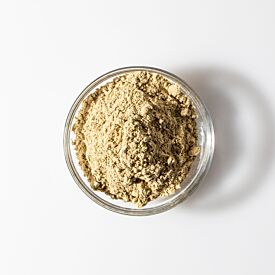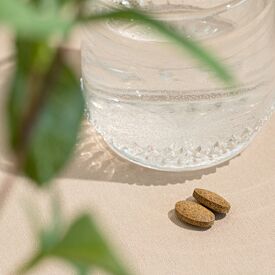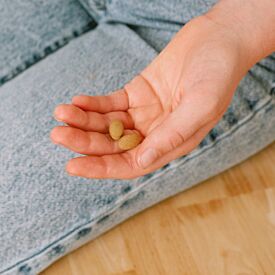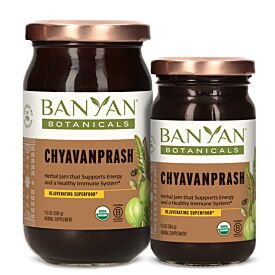The Benefits of Guduchi
The health promoting powers of guduchi, or Tinospora cordifolia, offer such a wide range of benefits that the plant has long been associated with the life-giving nectar of the gods. The ancient Ayurvedic texts called it "Amrita," meaning immortality, which speaks to the high regard this herb holds as an essential member of the Ayurvedic pharmacopeia. 1
As a rejuvenating tonic, guduchi bolsters immunity, promotes vitality, and supports longevity. It works on several organs and systems in the body and has been used in a wide range of health conditions, contributing to its reputation as an elixir of life. In fact, the word “guduchi” means something that protects the entire body. 2
In this article:
- Characteristics of the Guduchi Plant
- Guduchi Benefits and Uses
- How to Take Guduchi
- Modern Research on Guduchi
- Is Guduchi Safe?
- Growing and Harvesting Guduchi
Characteristics of the Guduchi Plant
Tinospora cordifolia, also known as guduchi or giloy, is just one of about 32 species of the genus Tinospora (Menispermaceae), a family of climbing shrubs that grow throughout various tropical regions of the world such as India, Africa, Madagascar, Australia, and the Pacific Islands. 3
Thriving at high altitudes, guduchi is a large, deciduous, climbing shrub with a fleshy stem and coiled branches. 4 It produces greenish-yellow flowers throughout the summer and winter,5 followed by single-seeded reddish colored fruits. 6 The vine has beautiful alternating heart-shaped leaves, explaining why it is also referred to as heart-leaved moonseed. 7
These particular plants are prized above all others, as their health benefits are believed to be enhanced by the synergy of these two powerful Ayurvedic herbal allies growing in tandem. 8
Due to its high nutritional content, the stem of the plant is the part most widely used in Ayurvedic herbal preparations and it is what Banyan’s guduchi powder is made from. However, the roots, bark, leaves, and fruits can also be used. 9

Guduchi Benefits and Uses
The wide-ranging health benefits of guduchi make this herb a powerful multi-tasker. Guduchi stands out in the world of Ayurvedic herbs because of its ability to support so many different organs, systems, and functions in the body. This power lies in its capacity to rejuvenate and strengthen the tissues, while also cleansing the entire system of ama, or built-up toxins. 10
Guduchi is known to support the body in the following ways:
- Boosts Immune Function: As an adaptogenic herb, guduchi can adapt to the body’s needs and lessen the impacts of stress, simultaneously promoting overall health and strengthening the immune system. 11,12,13
- Supports Liver Health: Guduchi helps strengthen and regenerate liver tissue and boost the liver’s natural ability to eliminate toxins. 14
- Promotes Joint Comfort: Guduchi clears accumulated toxins from the joints and strengthens joint tissue, promoting joint comfort and ease of movement. 15,16,17,18
- Soothes Irritated Skin: Guduchi’s cooling and pitta-balancing properties help relieve skin irritation and promote a healthy, lustrous complexion. 19
- Aids Healthy Digestion: It strengthens and stimulates digestion while helping balance intestinal flora. 20
- Regulates Metabolism and Blood-Sugar Levels: Guduchi helps maintain healthy blood sugar levels already in the normal range and regular, balanced metabolic function. 21,22
- Calms the Nervous System: Nourishing and rejuvenating for the nervous tissue, guduchi promotes a sense of stability, relaxation, and calm. 23,24
- Promotes Reproductive Health: It clears excess heat from the reproductive system while toning and rejuvenating the reproductive tissues. 25
Guduchi in Ayurveda
Guduchi has long been revered as a powerful healing herb in the Ayurvedic tradition. Like a trustworthy friend, it is dependable and consistent, ready to assist with a variety of physical woes. It’s also highly sattvic, said to infuse the user with lightness, clarity, and uplifting energy.
Guduchi has a unique and unusual set of energetics that make it beneficial for all three doshas and especially balancing for vata and pitta. Its rasa, or taste, is bitter, astringent, and pungent, helping clear both pitta and kapha from the system.
At the same time, it has a heating action, or virya, which makes it a powerful detoxifier, working to burn ama and accumulated natural toxins from the liver, kidneys, joints, and blood. Guduchi’s vipaka, or post-digestive effect, is sweet and unctuous, regulating vata and nourishing the tissues and fluids of the body. 26
Thanks to these unique energetics, guduchi boasts a long list of Ayurvedic actions and works to bring balance to the entire body, balancing multiple systems and tissue layers.
For starters, it reduces pitta in rakta dhatu (blood tissue layer) and soothes aggravated ranjaka pitta in the liver. Simultaneously, it regulates healthy blood sugar levels via rakta dhatu and meda dhatu, the fat tissue layer. It also tonifies and protects majja dhatu, the nervous tissues, and it acts as a rasayana, or rejuvenative for shukra dhatu, the reproductive tissues.
Modern Research on Guduchi
Research has been conducted in recent years regarding guduchi and the ways it benefits physical and emotional health. Here are a few of the most prominent studies on guduchi from the past decade:
- "The Chemical Constituents and Diverse Pharmacological Importance of Tinospora Cordifolia." Pubmed Extract. Sep 2019. 27
- "Medicinal Use of the Unique Plant Tinospora Cordifolia: Evidence from the Traditional Medicine and Recent Research." ResearchGate. Jan 2017. 28
- "Scientific Validation of the Medicinal Efficacy Of Tinospora Cordifolia." PubMed Extract. Dec 2013. 29
- "Tinospora Cordifolia: One Plant, Many Roles." PubMed Extract. Apr 2012. 30
- "Chemistry and Pharmacology of Tinospora Cordifolia." SagePub. Nov 2016. 31
How to Take Guduchi
Thanks to guduchi’s versatile nature, it can be used to support many different aspects of health and well-being. This is an inexhaustive list of the many ways it can be taken, according to some of the herb’s main benefits:
Traditional Method for Overall Support. For an easy traditional method of enjoying guduchi’s benefits, take ¼ to ½ teaspoon of guduchi powder, once to twice daily. It can be mixed with warm water or incorporated into another dosha-appropriate anupan, or carrier substance, such as honey, milk, or ghee.
Support the Immune System. For a tasty, immune-boosting tonic, you can take Chyavanprash, a traditional Ayurvedic jam that blends guduchi with several other health-promoting herbs in a base of honey and ghee.
Promote Healthy Skin. To cleanse toxins from the blood and support the clarity and radiance of the skin, try taking Blood Cleanse tablets or Healthy Skin. Guduchi can also be used topically with Daily Massage Oil, Pitta Massage Oil, and Soothing Skin Balm.
Support Comfortable Joints: Guduchi is excellent for helping promote joint comfort and ease of motion. Take Joint Support tablets for internal support, and Joint Balm or Mahanarayan Oil for external use.
Foster a Healthy Mind and Nervous System. Guduchi’s nourishing and sattvic qualities help strengthen the nervous system, protect from stress, and calm the mind. Stress Ease, Tranquil Mind, and I Sleep Soundly are great choices for this area of health.
Promote Reproductive Health. To support the health of the reproductive system, try taking Women’s Support or Women’s Natural Transition. Guduchi is also included in Breast Care Balm, which is a wonderful way to nourish and support healthy breast tissue.
Is Guduchi Safe?
Guduchi is a rejuvenating, adaptogenic herb that is generally considered safe for all doshas and is especially beneficial for vata and pitta. That said, there are a couple of instances in which it’s best to exercise caution.
Contraindications
Because of its powerful work in the immune system, guduchi may potentially cause over-activity of immune function in the case of autoimmune disease. 32 It is also best to use caution when taking medication that lowers blood sugar levels. 33
For those who are pregnant, nursing, or taking medications, we recommend speaking to your doctor or Ayurvedic practitioner before taking guduchi.
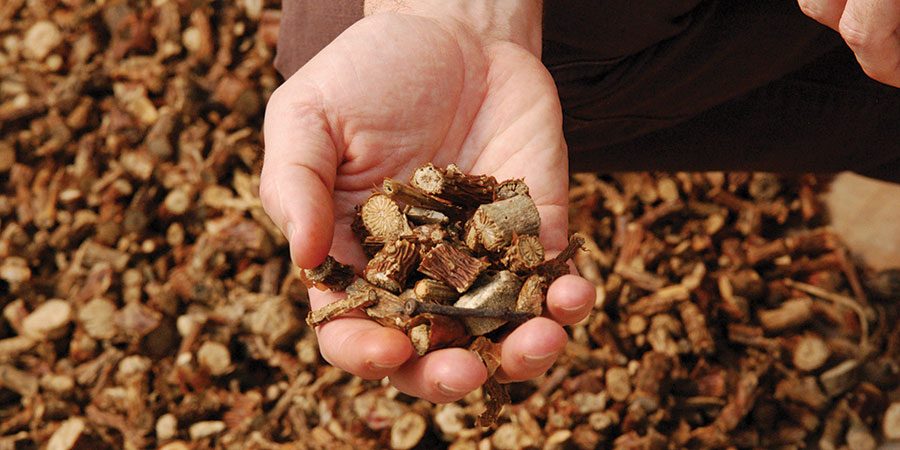
The Growing and Harvesting of Banyan’s Guduchi
Banyan’s guduchi is sourced from plants that are cultivated on three different farms, all based in the Northwest Indian state of Rajasthan. The vines are grown on neem trees and other boundary trees on the farms, which create an ideal environment for the plants to thrive.
The farmers plant the guduchi roots near an existing tree, and being a natural climber, it takes care of the rest by itself.
After one and a half to two years, the stem has matured and is ready to harvest. At this point, the entire stem is cut, and the roots are left to regrow for the next season. The harvested stems are chopped into smaller pieces and naturally sun-dried.
Sustainability of Guduchi
Because we cultivate our own plants, there are no sustainability concerns for our guduchi. However, this doesn’t necessarily apply to all guduchi on the market. Because of commercial demand, there could be sustainability issues in the future for other sources of guduchi.
This is something to watch—and it makes sourcing transparency all the more important.
As a part of a larger conversation regarding the sustainability of Ayurvedic herbs, it is important to understand where and how plants are grown and harvested.
We ensure sustainability by sourcing botanicals that are either cultivated and harvested on privately owned, organic farms, or are harvested from legal wild-craft sourcing. Our herbs and ingredient-producing plants are harvested at optimal times, using environmentally sustainable practices sensitive to the long-term health of the plants.


